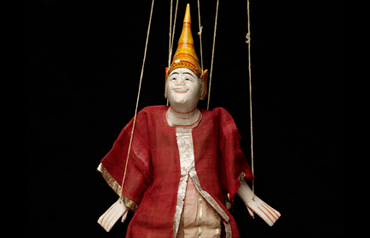Dramatic Museum Realia |

|
James Brander Matthews (1852–1929), America’s first professor of dramatic literature, created a Dramatic Museum at Columbia in 1911 to supplement his teaching. He insisted that material objects and images were crucial to understanding drama, and that theater knew no geographical or chronological bounds. The differences in national style visible on the contemporary stage had their origins, he argued, in ancient local rituals and religious practice. So in addition to considerable manuscript collections and a large collection of printed books, the Dramatic Museum included 34,500 theatrical portraits (prints and photographs); 2,350 speech recordings; 35,000 eighteenth-, nineteenth- , and twentieth-century playbills; approximately 600 artworks, including costume and scenic designs and posters; 392 puppets and 128 masks; 12 models of historical theaters; and 29 stage sets.
The Museum was formally dissolved and its collections dispersed in 1971. By the 1990s, the collections had all gravitated to the Rare Book and Manuscript Library (RBML). Manuscripts and printed books have been assimilated into our collections as a number of archival collections and as individual items cataloged into the online catalog, CLIO. Later, the posters, programs, playbills, subject files, lantern slides, scrapbooks, and portraits were made into the Dramatic Museum Ephemera collection.
Now, thanks to a grant from the Gladys Krieble Delmas Foundation, RBML is creating a new collection and finding aid. Dramatic Museum Realia consists of puppets, masks, theater models and stage sets. The puppets and masks have all been photographed, and these images are presented here.
The puppets come from around the world: Africa, Burma, China, England, France, Haiti, India, Indonesia, Italy, Japan, Mexico, Thailand, Turkey, Russia, and the U.S. There are 40 large (over five feet tall) shadow puppets and approximately 350 other puppets, including six oversize marionettes made by the prominent artist Remo Bufano. Most were collected by the 1930s; many date from the nineteenth century. The masks have a similar range: they come from Africa, Ceylon, Europe, Japan, Java, Mexico, North America, Sri Lanka, and Thailand.
A card catalog was created for the puppets and masks in the 1960s during what would prove to be the last years of the Dramatic Museum. We have taken what information we could from the catalog cards, supplemented by the Museum’s office files, and past exhibition labels, and edited it.
YOU CAN HELP US!
We now ask those who view the online images to send corrections and additions to these descriptions, via the easy “send feedback” boxes on the pages for the individual items. We will use the information you send to correct and augment the data presented. The email we receive will automatically tell us the item number you are discussing.
Thank you for your help!